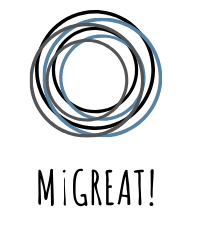The Migreat Project Guide: concepts, methods, activities and good practices
Written by Mariana Hanssen (ELAN Interculturel)
In February 2020 we started our first discussions on how to plan our written manual. Putting into words our daily experiences at work appeared to us a huge challenge. However, we knew that fleeting interactions were not enough to affect people in the long term: writing everything down was our answer to record our methods, thoughts, and discoveries and make it possible to replicate and build on them in the future.
It was an intense adventure: research, writing, discussions, cross readings, corrections, more research, even more writing. We had to stop ourselves from getting too creative otherwise we would have written a series of books about the subject – but I can confirm that we have already written a pretty extensive book, a very complete one with a balance between theory and practice, abstract and real.
What can you find in there?
Our guide is divided in 4 chapters:
- Introduction
We start our guide by building common ground. We present the project and our aims, why are we doing it. We explain what we understand by narratives, counter and alternative ones, and why it is important to work on them. Also, from our perspective, it was important to present our contexts. Therefore, we briefly introduce the reality from our four countries (Italy, France, Great Britain and Hungary) with theoretical and real examples of how migration is lived in each corner. This is also an invitation for our readers to reflect and search for their own realities: in order to change our community, we need to understand it.
2. Methods to create alternative narratives
Secondly, we presented our expertise: the three methods that were used in the project to build our counter and alternative narratives (Pedagogy of the Oppressed, Theatre and Community Organising). In this chapter, it is possible to understand the link between the methods and changing narratives and understand the innovative step that Migreat took when applying all of these approaches.
3. Tools and practical activities
In this third chapter, the reader will find all the activities that we created. Using our methods, we wrote systematically how to lead workshops and shared valuable tips.
4. Collection of good practices
Finally, we connected our work with what is already happening in the world around the transformation of narratives. At this point, it is possible to get to know inspiring initiatives in our four countries, and get ready to support one (or develop your own, why not!).
Why is it powerful?
Narratives are stories that circulate in societies. They emerge from shared social beliefs and also act to reinforce them, while guiding decisions and actions of individuals and groups. They depict reality in a partial way, through a particular point of view. Some of them are more dominant than others, but that can change. In most European countries, dominant narratives about migration and migrants from low-income countries seem to be dehumanising and/or essentialising, especially since the ‘migrant crisis’ in the middle of the 2010s and the growing popularity of far-right discourse and policies that seem to influence the political discourse across the continent.
Developing narratives allows a certain freedom about which points of view we wish to put forward, allowing different points of view to coexist. It allows for a questioning of ideas and concepts that are somehow ‘normalised’ in a society, for example universalism and egalitarianism. This evokes fruitful debates.
We recommend this reading for educators and activists in the field of social work, migrants rights and others, who have some practical experience. We did our best to present an overview but encourage readers to go deeper: read the references, participate in training, test out our activities and share with partners. Our partnership is also happy to hear your feedback and support you in this process.Enjoy your reading, share it with others, and, most importantly: participate actively in the process of changing migration narratives.
